Retractions occur - Study guides, Class notes & Summaries
Looking for the best study guides, study notes and summaries about Retractions occur? On this page you'll find 2044 study documents about Retractions occur.
Page 4 out of 2.044 results
Sort by
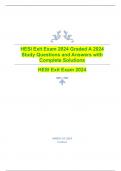
-
HESI Exit Exam 2024 Graded A 2024 Study Questions and Answers with Complete Solutions
- Exam (elaborations) • 292 pages • 2024
-
- $15.99
- + learn more
What PO2 value indicates respiratory failure in adults? PO2 < 60 mmHg What blood value indicates hypercapnia? PCO2 > 45 mmHg What condition occurs when the PO2 is < 60 mmHg (acute hypoxemia), the CO2 tension rises > 50 mmHg (acute hypercarbia, hypercapnia) & the pH drops < 7.35, or both? Acute respiratory failure What are the S/S of respiratory failure in adults? Dyspnea, SOB Tachypnea Intercostal & sternal retractions Cyanosis Tachycardia Cough that produces sputum...
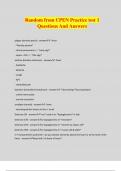
-
Random from CPEN Practice test 1 Questions And Answers
- Exam (elaborations) • 25 pages • 2024
- Available in package deal
-
- $13.49
- + learn more
Random from CPEN Practice test 1 Questions And Answers plague (yersinia pestis) - answer- fever - *bloody sputum* - clinical pneumonia <-- *early sign* - sepsis + DIC <-- *late sign* anthrax (bacillius anthracis) - answer- fever - headache - dyspnea - cough - N/V - chest/abd pain botulism (clostridium botulinum) - answer-*descending* flaccid paralysis - cranial nerve palsy - normal mentation smallpox (variola) - answer- fever - vesiculopustular leisons in face + trunk Dext...
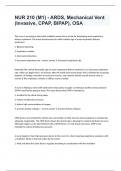
-
NUR 210 (M1) - ARDS, Mechanical Vent (Invasive, CPAP, BIPAP), OSA with complete solutions 2024
- Exam (elaborations) • 25 pages • 2024
- Available in package deal
-
- $17.99
- + learn more
NUR 210 (M1) - ARDS, Mechanical Vent (Invasive, CPAP, BIPAP), OSAThe nurse is assessing a client with multiple trauma who is at risk for developing acute respiratory distress syndrome. The nurse should assess for which earliest sign of acute respiratory distress syndrome? 1. Bilateral wheezing 2. Inspiratory crackles 3. Intercostal retractions 4. Increased respiratory rate - correct answer 4. Increased respiratory rate Rationale:The earliest detectable sign of acute respiratory distress s...
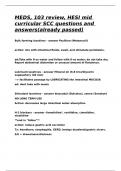
-
MEDS, 103 review, HESI mid curricular SCC questions and answers(already passed).
- Exam (elaborations) • 32 pages • 2024
-
- $13.49
- + learn more
Levels of Health Promotion primary, secondary, tertiary Application Examples of Levels of Promotion primary- weight loss, diet, smoking cessation Secondary- papsmears, mammograms, testicular exams Tertiary- medication therapy, surgical treatment, physical therapy, teaching foot care education to diabetic care Previous Play Next Rewind 10 seconds Move forward 10 seconds Unmute -- / -- Full screen Brainpower Read More Primary promotes health and preventing developm...
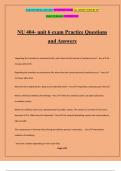
-
NU 404- unit 6 exam Practice Questions and Answers
- Exam (elaborations) • 43 pages • 2024
-
- $12.49
- + learn more
NU 404- unit 6 exam Practice Questions and Answers Regarding the transition to extrauterine life, when does the first period of reactivity occur? - Ans:-30 minutes after birth Regarding the transition to extrauterine life, when does the second period of reactivity occur? - Ans:- 2-8 hours after birth What are the 3 adjustments a baby must make after birth? - Ans:-respiratory, cardiovascular, thermal What is chemical initiation of breathing? - Ans:-when the umbilical cord is cut (utero-pla...
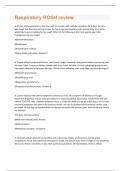
-
Respiratory ROSH review Questions And Answers Rated A+ New Update Assured Satisfaction
- Exam (elaborations) • 19 pages • 2024
- Available in package deal
-
- $7.99
- + learn more
A 10-year-old boy presents to the clinic with his mother with cold-like symptoms for 4 days. He has a wet-cough that has been persistent over the last 4 days and interferes with outside play. His mother would like to get something for his cough. Which of the following is the most appropriate initial management for his cough? ADextromethorphan BGuaifenesin CPromethazine-codeine DWarm fluids and honey - Answer-D A 10-year-old girl presents with fever, sore throat, cough, headache, and gene...
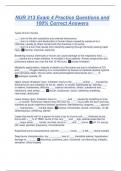
-
NUR 313 Exam 4 Practice Questions and 100% Correct Answers
- Exam (elaborations) • 28 pages • 2024
-
- $12.99
- + learn more
Types of burn injuries ___ : burn to the skin caused by any external heat source ___ : burn is irritation and destruction of human tissue caused by exposure to a chemical, usually by direct contact with the chemical or its fumes. ___ : burn is a burn that results from electricity passing through the body causing rapid injury thermal, chemical, electrical Breathing noxious chemicals or hot air can cause damage to the respiratory tract. ___ ___ injuries are a major predictor of mortality in burn...
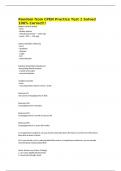
-
Random from CPEN Practice Test 1 Solved 100% Correct!!
- Exam (elaborations) • 24 pages • 2024
- Available in package deal
-
- $11.50
- + learn more
Random from CPEN Practice Test 1 Solved 100% Correct!! plague (yersinia pestis) - fever - bloody sputum - clinical pneumonia <-- early sign - sepsis + DIC <-- late sign anthrax (bacillius anthracis) - fever - headache - dyspnea - cough - N/V - chest/abd pain botulism (clostridium botulinum) -descending flaccid paralysis - cranial nerve palsy - normal mentation smallpox (variola) - fever - vesiculopustular leisons in face + trunk Dextrose 5% not used to ...
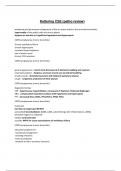
-
Kettering CSE (patho review)
- Exam (elaborations) • 24 pages • 2024
- Available in package deal
-
- $9.29
- + learn more
Kettering CSE (patho review) weakening and permanent enlargement of the air spaces distal to the terminal bronchioles. hypertrophy of the goblet cells and mucus glands dyspnea on exertion w/ significant hypoxemia and hypercapnia COPD (emphysema chronic bronchitis) chronic ventilatory failure chronic hypercapnia increased lung compliance loss of elastic recoil chronic CO2 retention COPD (emphysema chronic bronchitis) general appearance - barrel chest (increased A-P diameter)...
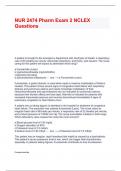
-
NUR 2474 Pharm Exam 2 NCLEX Questions
- Exam (elaborations) • 35 pages • 2024
-
- $11.49
- + learn more
A patient is brought to the emergency department with shortness of breath, a respiratory rate of 30 breaths per minute, intercostal retractions, and frothy, pink sputum. The nurse caring for this patient will expect to administer which drug? a.Furosemide (Lasix) b.Hydrochlorothiazide (HydroDIURIL) c.Mannitol (Osmitrol) d.Spironolactone (Aldactone) - ans ----a.Furosemide (Lasix) Furosemide, a potent diuretic, is used when rapid or massive mobilization of fluids is needed. This patien...

How did he do that? By selling his study resources on Stuvia. Try it yourself! Discover all about earning on Stuvia


